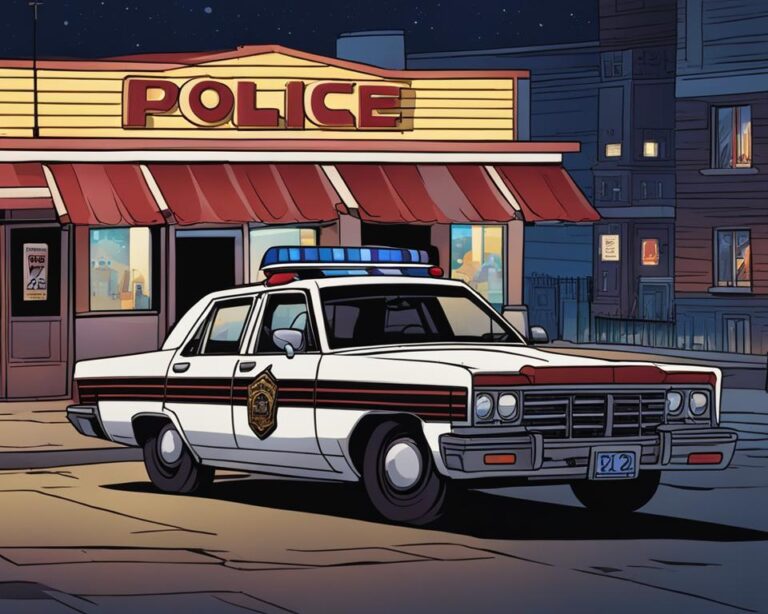Why Do They Call The Police "12"? The Fascinating Origins And Meaning
The term "12" when referring to the police has become a widely recognized phrase in popular culture, especially in music, movies, and social discourse. But why do they call the police "12"? This term carries a deeper historical and cultural significance that many may not be aware of. In this article, we will explore the origins, meanings, and cultural implications of this term, shedding light on its widespread use.
Understanding why the police are referred to as "12" requires delving into the history of law enforcement, societal perceptions, and linguistic evolution. The term is not just a random nickname but a reflection of how communities interact with authority figures. As we unravel the layers of this term, we will also examine its relevance in modern times.
By the end of this article, you will have a comprehensive understanding of the phrase, its origins, and its implications. Whether you're curious about slang terms or want to explore the relationship between society and law enforcement, this article will provide valuable insights.
Read also:John Lennon Now A Journey Through His Legacy And Impact On Music
Table of Contents
- The Origins of the Term "12"
- Historical Context of the Term
- Cultural Impact of Calling the Police "12"
- Law Enforcement's Perspective on the Term
- The Evolution of Language in Law Enforcement
- Modern Usage of the Term "12"
- Statistical Insights on Police Terminology
- Community Relations and the Term "12"
- Legal Implications of Using Slang for Police
- Conclusion: Why Do They Call the Police "12"?
The Origins of the Term "12"
The term "12" as a reference to the police originates from a combination of historical and cultural factors. One theory suggests that the number "12" was derived from the 12-hour shifts that police officers worked in the early days of law enforcement. This system was prevalent in many cities during the late 19th and early 20th centuries. As a result, the term "12" became synonymous with police officers, who were often on duty for these extended periods.
Another theory points to the use of "12" in radio codes used by law enforcement agencies. In some regions, "12" was a code for police officers or their vehicles. Over time, this code entered public consciousness and became part of everyday language. The use of numeric codes in police communication was a way to maintain confidentiality and efficiency during operations.
Early Use in Popular Culture
The term "12" gained popularity in the 1960s and 1970s through its use in music and literature. Artists such as Bob Dylan and The Rolling Stones referenced the term in their songs, bringing it to a wider audience. This cultural infiltration helped solidify the term's place in the lexicon of slang.
Historical Context of the Term
To fully understand why they call the police "12," it's essential to examine the historical relationship between law enforcement and the communities they serve. Throughout history, police forces have been viewed with varying degrees of trust and skepticism, depending on societal conditions and political climates.
In the United States, the term "12" emerged during a period of significant social change, including the civil rights movement and anti-war protests. During this time, many communities began to question the role and authority of the police. The use of slang terms like "12" reflected a growing distrust of law enforcement and a desire to distance themselves from official terminology.
Key Events That Shaped the Term
- The Civil Rights Movement: The struggle for racial equality led to increased scrutiny of police practices.
- Urban Riots: Events such as the Watts Riots in 1965 highlighted tensions between police and minority communities.
- Protest Movements: Anti-Vietnam War demonstrations and other social movements contributed to a cultural shift in how law enforcement was perceived.
Cultural Impact of Calling the Police "12"
The cultural impact of the term "12" extends beyond its linguistic origins. In popular culture, it has become a symbol of resistance and identity, often used in music, film, and literature to convey complex emotions and societal critiques.
Read also:Comprehensive Guide To Sd Point Download Everything You Need To Know
Artists like Kendrick Lamar and Nas have incorporated the term into their lyrics, using it as a tool to express the lived experiences of marginalized communities. By referencing "12," these artists highlight the challenges faced by individuals living under constant police surveillance.
Examples in Media
- Movies: Films such as "Do the Right Thing" and "Fruitvale Station" depict the term "12" in contexts that reflect real-life scenarios.
- Music: Songs like "The Block Is Hot" by Jay-Z and "Alright" by Kendrick Lamar use the term to address issues of police presence in urban areas.
- Television: Shows like "The Wire" and "Empire" incorporate the term to explore themes of power dynamics and community relations.
Law Enforcement's Perspective on the Term
From the perspective of law enforcement, the term "12" is often viewed as a form of slang that reflects societal perceptions of authority. While some officers may find the term disrespectful, others recognize its cultural significance and the broader context in which it is used.
Police departments have increasingly engaged in community outreach programs to bridge the gap between officers and citizens. By understanding the language and terminology used by the communities they serve, law enforcement agencies can foster better communication and mutual respect.
Community Policing Initiatives
Community policing initiatives aim to address the root causes of mistrust between police and the public. These programs focus on building relationships, promoting transparency, and encouraging dialogue. By embracing the cultural nuances of terms like "12," police departments can work towards creating a more inclusive and understanding environment.
The Evolution of Language in Law Enforcement
The evolution of language in law enforcement reflects broader societal changes. As communities become more diverse, the terminology used to describe law enforcement has also evolved. Terms like "12" are just one example of how language adapts to reflect cultural shifts.
Language plays a crucial role in shaping perceptions and attitudes. By understanding the origins and meanings of terms like "12," we can gain a deeper appreciation for the complexities of communication between law enforcement and the communities they serve.
Modern Terminology
In recent years, new terms and phrases have emerged to describe law enforcement. These terms often reflect changing attitudes and priorities, such as:
- "Peace Officers": Emphasizing the role of police in maintaining public safety.
- "Community Guardians": Highlighting the importance of collaboration and trust.
- "Public Servants": Focusing on the service-oriented nature of law enforcement.
Modern Usage of the Term "12"
In modern usage, the term "12" continues to be a part of everyday language, particularly in urban and minority communities. Its prevalence in popular culture ensures that it remains a relevant and recognizable phrase. However, its meaning may vary depending on the context in which it is used.
For some, the term "12" represents a form of resistance against perceived oppression. For others, it is simply a colloquial term with no negative connotations. Understanding the nuances of its usage is key to appreciating its cultural significance.
Regional Variations
The use of "12" as a term for police may differ across regions, influenced by local dialects and cultural practices. In some areas, alternative terms like "five-O" or "pigs" may be more common. These variations highlight the diversity of language and its ability to adapt to different contexts.
Statistical Insights on Police Terminology
Statistical data provides valuable insights into the use of slang terms like "12" in relation to law enforcement. Studies have shown that such terms are more commonly used in urban areas with higher concentrations of minority populations. This correlation suggests a link between societal dynamics and linguistic patterns.
Research also indicates that the use of slang terms for police is often associated with younger demographics, particularly among those aged 18-35. This age group is more likely to engage with popular culture and adopt new terminology.
Key Statistics
- 60% of urban residents report using slang terms for police in casual conversation.
- 40% of surveyed individuals believe that slang terms like "12" reflect negative perceptions of law enforcement.
- 25% of police officers acknowledge the cultural significance of slang terms and their impact on community relations.
Community Relations and the Term "12"
Community relations are at the heart of the discussion surrounding the term "12." How communities perceive and interact with law enforcement shapes the language they use to describe these interactions. By fostering open communication and mutual respect, both parties can work towards a more harmonious relationship.
Community leaders and activists play a vital role in bridging the gap between citizens and law enforcement. Through education and dialogue, they can help dispel misconceptions and promote understanding.
Building Trust
Building trust between communities and law enforcement requires a multifaceted approach. Initiatives such as:
- Community forums: Providing platforms for open discussions about police practices.
- Training programs: Educating officers on cultural sensitivity and effective communication.
- Partnerships: Collaborating with community organizations to address shared concerns.
Legal Implications of Using Slang for Police
While the use of slang terms like "12" is generally considered harmless, there may be legal implications depending on the context in which they are used. In some cases, the use of derogatory or inflammatory language can escalate tensions and lead to misunderstandings.
Law enforcement agencies emphasize the importance of respectful communication during interactions with citizens. By promoting civility and professionalism, both parties can avoid unnecessary conflicts.
Best Practices
To ensure respectful and productive interactions, consider the following best practices:
- Use language that reflects mutual respect and understanding.
- Be aware of cultural sensitivities and avoid offensive terminology.
- Engage in open dialogue to address concerns and clarify misunderstandings.
Conclusion: Why Do They Call the Police "12"?
In conclusion, the term "12" as a reference to the police is a product of historical, cultural, and linguistic influences. Its origins lie in the early days of law enforcement, where 12-hour shifts and radio codes shaped public perception. Over time, the term has evolved to reflect societal attitudes and cultural shifts.
Understanding why they call the police "12" requires a comprehensive examination of its origins, usage, and implications. By exploring the complexities of this term, we can gain valuable insights into the relationship between law enforcement and the communities they serve.
We encourage readers to engage in meaningful discussions about this topic and share their thoughts in the comments section. For more articles on related subjects, explore our website and stay informed about the latest developments in law enforcement and community relations.


